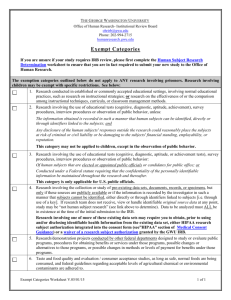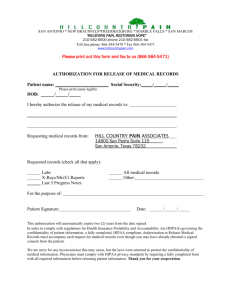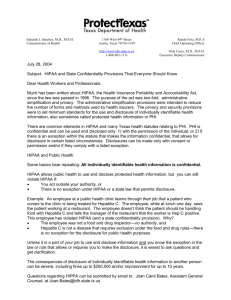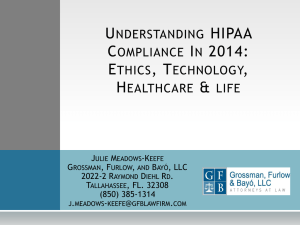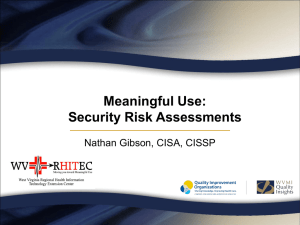10-1 HIPAA Requirements in Research
advertisement
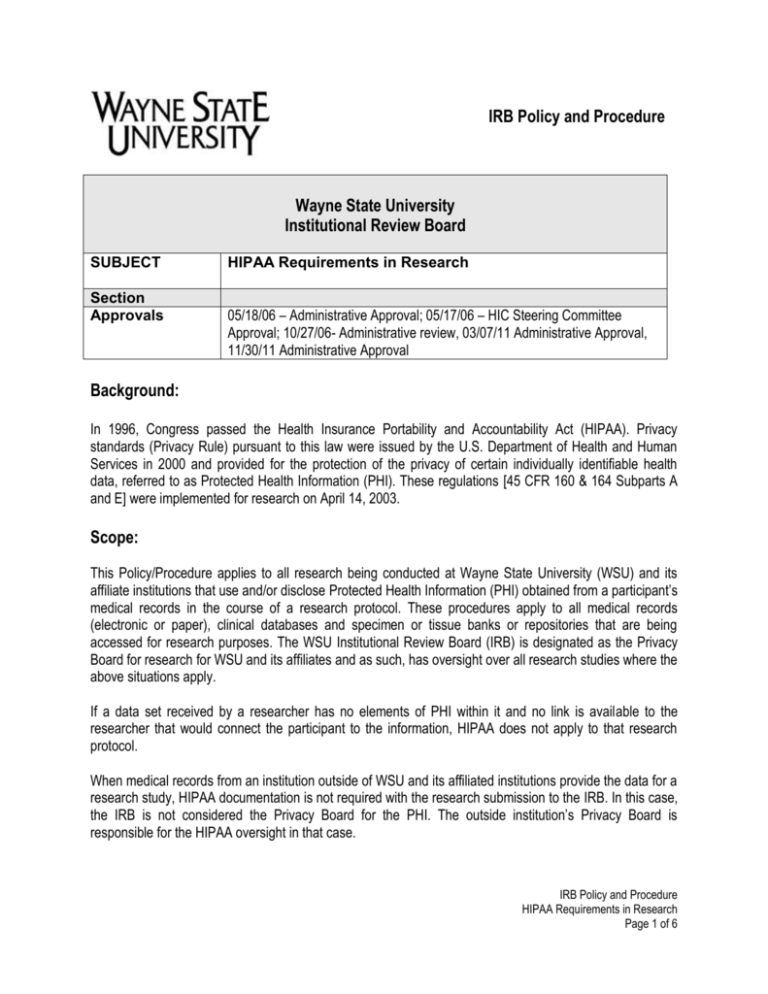
IRB Policy and Procedure Wayne State University Institutional Review Board SUBJECT Section Approvals HIPAA Requirements in Research 05/18/06 – Administrative Approval; 05/17/06 – HIC Steering Committee Approval; 10/27/06- Administrative review, 03/07/11 Administrative Approval, 11/30/11 Administrative Approval Background: In 1996, Congress passed the Health Insurance Portability and Accountability Act (HIPAA). Privacy standards (Privacy Rule) pursuant to this law were issued by the U.S. Department of Health and Human Services in 2000 and provided for the protection of the privacy of certain individually identifiable health data, referred to as Protected Health Information (PHI). These regulations [45 CFR 160 & 164 Subparts A and E] were implemented for research on April 14, 2003. Scope: This Policy/Procedure applies to all research being conducted at Wayne State University (WSU) and its affiliate institutions that use and/or disclose Protected Health Information (PHI) obtained from a participant’s medical records in the course of a research protocol. These procedures apply to all medical records (electronic or paper), clinical databases and specimen or tissue banks or repositories that are being accessed for research purposes. The WSU Institutional Review Board (IRB) is designated as the Privacy Board for research for WSU and its affiliates and as such, has oversight over all research studies where the above situations apply. If a data set received by a researcher has no elements of PHI within it and no link is available to the researcher that would connect the participant to the information, HIPAA does not apply to that research protocol. When medical records from an institution outside of WSU and its affiliated institutions provide the data for a research study, HIPAA documentation is not required with the research submission to the IRB. In this case, the IRB is not considered the Privacy Board for the PHI. The outside institution’s Privacy Board is responsible for the HIPAA oversight in that case. IRB Policy and Procedure HIPAA Requirements in Research Page 1 of 6 When health information is collected directly from the participant in a research study through interviews, questionnaires or surveys, and if the research team will never access medical records to verify that information, HIPAA oversight by the IRB is not required. Definitions: Covered Entity: A health plan, health care clearinghouse, and health care providers that transmit health information electronically in connection with certain defined HIPAA transactions such as claims or eligibility inquiries. Researchers are not usually considered covered entities unless they are also health care providers and engage in any of the covered electronic transactions. If a researcher is an employee or other workforce member of a covered entity, they may need to comply with HIPAA privacy policies for research for that entity. Data Use Agreement: The agreement that should be used between the Principal Investigator (PI) at WSU and the entity to whom the three elements or less of PHI that are considered in a Limited Data Set (see definition below) are being disclosed outside of WSU, but only when the WSU researcher is using only these three elements. A HIPAA Authorization is not required in this case. The IRB template for the Data Use Agreement (DUA) can be found at the IRB website at the HIPAA link (http://www.irb.wayne.edu/hipaa.html). De-Identified Data Set: A data set that has had all 18 elements of PHI removed prior to being available to the PI and his/her research staff members for research purposes. Disclosure: The release, transfer, access to, or the divulging of information in any manner outside the entity holding the information. At WSU, when an outside monitor reviews PHI within a medical record or source documents at WSU or one of its affiliate institutions it is not considered a disclosure. Health Information: Any information whether oral or recorded in any form that is: 1) created or received by a health care provider, health plan, public health authority, employer, life insurer, school or university or health care clearinghouse, and 2) relates to the past, present or future physical or mental health or condition of an individual; provision of health care to an individual; or the past, present, or future payment for the provision of health care to an individual. Individually Identifiable Health Information: A subset of health information, including demographic information collected from an individual, and: 1) is created or received by a health care provider, health plan, employer, http://www.irb.wayne.edu/hipaa.html or health care clearinghouse, and 2) relates to the past, present, or future physical or mental health or condition of an individual; the provision of health care to an individual; or the past, present, or future payment for the provision of health care to an IRB Policy and Procedure HIPAA Requirements in Research Page 2 of 6 individual, and a) identifies the individual, or b) with respect to which there is a reasonable basis to believe the information can be used to identify the individual. Limited Data Set: When a researcher at WSU and its affiliates is using only the elements of PHI that include: 1) the address greater than street address, 2) elements of dates and 3) the unique identifying number, characteristic or code. Privacy Board: A board that is established to review and approve requests for waivers or alterations of authorization regarding use or disclosure of PHI. In the case of WSU and its affiliate institutions, including the John D. Dingell VA Medical Center (JDD VAMC), the IRB serves as the privacy board to review the effect of a research protocol on an individual’s privacy rights and related interests. Protected Health Information (PHI): Individually identifiable health information that is transmitted by electronic media, maintained in electronic media, or is transmitted or maintained in any other form or medium (e.g., paper records). PHI is comprised of the following elements: name, address, dates, telephone, fax, e-mail, medical record number, social security number, health beneficiary number (health insurance), account numbers like credit card numbers, certificate or license numbers, vehicle and serial numbers, device Identification numbers and serial numbers, Web URLs, Internet Protocol addresses (IP), biometric identifiers such as voice or fingerprints, full face photographs or comparable images, and any unique identifying numbers, characteristics, or codes. Use: The sharing, employment, application, utilization, examination, or analysis of individually identifiable health information for research purposes within the health entity that maintains the information. Waiver of Authorization: Permission from the IRB (Privacy Board) in response to a request by the PI to obtain elements of PHI in a research protocol without prior authorization from the participant. 1. Complete Waiver of Authorization: When the IRB determines that no Authorization is required for a research project. 2. Partial Waiver of Authorization: This occurs when the IRB determines that a covered entity does not need Authorization for all PHI uses and disclosures. Procedures: When activities outside of the normal business of the facility (health care activities) that access in- or outpatient medical records (retrospective or prospective), clinical data bases, or tissue banks, HIPAA documentation is required with each research submission. IRB Policy and Procedure HIPAA Requirements in Research Page 3 of 6 Preparation for Research: HIPAA regulations allow a researcher to access PHI to adequately prepare for research. This can occur when PHI is necessary to prepare a research protocol, establish whether or not there are enough eligible participants available for the research or to access information for planned recruitment. These preparatory steps do not require IRB (Privacy Board) review and approval prior to accessing PHI to prepare a protocol or determine its feasibility; however, the recruitment plan must be submitted to the IRB and approved with the protocol before the planned study is started. A researcher is allowed to access PHI without a waiver of authorization, signed authorization, or data use agreement when reviewing the information prior to initiating the study (e.g., chart review for eligibility) and the PHI will not be removed from the covered entity where it is held. Issues of HIPAA and Recruitment: Initial Recruitment Steps at WSU- the IRB requires that a person in a clinical relationship with the participant be the one to introduce the potential participant to the study. If the participant is interested, the research personnel can then be introduced to the participant and start the consent and enrollment processes. This can be done in several ways. 1. Face-to-face introductions in the clinical setting. 2. Letters, information sheets or other documents generated from the clinician’s office that are mailed our or given to patients in the clinical setting. The document can be used to introduce the potential participant to the research study and inform him/her that he/she may be called regarding the research. These contact documents should allow the participant to refuse a contact by the research team member if he/she chooses. If the researcher does have a clinical relationship with the potential participant, he/she can provide the initial introduction of the study and proceed with the in-depth consent and enrollment process with verbal permission from the potential participant. Prior to beginning any of these activities, the IRB must approve the introductory phase of the recruitment process. HIPAA Documentation Required for Initial Submission of Protocols 1. Protocol Summary Form: a. Check the appropriate boxes regarding sources of data b. Indicate who will be doing the initial contact of the participant to introduce the study. 2. Informed Consent Document: a. WSU Research: The WSU consent template includes the HIPAA Authorization documentation after the consent signature page. The documentation of HIPAA Authorization is considered a separate process from the informed consent process; however, it is not included in the consent template. Separate signatures are required. 3. HIPAA Summary Form: a. This form provides the IRBs with information needed to oversee application of HIPAA requirements to research projects being conducted within the institution. b. Submit one copy of the HIPAA Summary Form with the protocol submission. IRB Policy and Procedure HIPAA Requirements in Research Page 4 of 6 4. HIPAA Waiver of Authorization: a. To Waiver of Authorization, Section F of the HIPAA Summary Form must be completed in detail and the request signed by the PI on the last page. b. The Waiver of Authorization must be reviewed and approved by the IRB and documented in the approval memo for the protocol. c. In order for the IRB to approve the Waiver of Authorization, the request must satisfy the following criteria: 1. The use or disclosure involves no more than minimal risk to the privacy of individuals based on the presence of the following elements. 2. An adequate plan to protect health information identifiers from improper use and disclosure. 3. An adequate plan to destroy identifiers at the earliest opportunity consistent with conduct of the research. 4. Adequate written assurances that the PHI will not be reused or disclosed to any other person or entity, except as required by law, for authorized oversight of the research or for other research for which the use or disclosure of the PHI would be permitted. 5. The research could not practicably be conducted without the waiver or alteration. 6. The research could not practicably be conducted without access to and use of the PHI. 5. HIPAA Authorization Form: (Attached to the end of the Informed Consent Template) a. This required document provides specific information to the research participant regarding the use and or disclosure of his/her PHI for research purposes and his/her rights under the law. b. When research participants sign this form, they are authorizing use/and or disclosure of the PHI specified within the document for a particular research study. At WSU, the authorization is now a part of the informed consent template. Separate participant signatures are required in the HIPAA Authorization section of the template as well as the consent section. c. The JDD has a required HIPAA Authorization Form that is separate from their consent form. d. Submit two clean copies of the HIPAA Authorization section with the protocol submission and the informed consent documents. 6. If information within the HIPAA Summary Form and HIPAA Authorization changes after the initial forms are approved, (i.e. The addition or deletion of Uses or Disclosures), the submission of an amendment to the IRB must be submitted. Please refer to the HIPAA Flow Chart and the HIPAA Tip Sheet located under the HIPAA Link at www.irb.wayne.edu to assist in determining what documents are required for submissions. IRB Policy and Procedure HIPAA Requirements in Research Page 5 of 6 Unauthorized Use or Disclosure of PHI: Anytime there is an unauthorized use or disclosure of PHI involving research or a breach in the protection of the privacy of the PHI, the IRB must be notified immediately. This constitutes an unexpected event according to federal regulations (Office of Human Research Protections (OHRP), The Food and Drug Administration (FDA), and the Office of Research Oversight (ORO) and must be reported to the appropriate federal entities as well as institutional officials. See the IRB Policy/Procedure:” Reporting Unanticipated Problems, Suspensions, Terminations, and Continuing and Serious Noncompliance” Failure to adhere to the HIPAA Privacy Rule can result in institutional and individual fines. IRB Policy and Procedure HIPAA Requirements in Research Page 6 of 6

